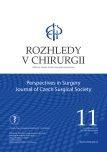-
Medical journals
- Career
Minimally-invasive pancreatic surgery in high volume centers in the Czech Republic – current status and possible implementations
Authors: M. Loveček 1; P. Záruba 2; J. Ulrych 3; J. Froněk 4; M. Oliverus 5; F. Čečka 6; J. Hlavsa 7; J. Šimša 8; L. Sirotek 9; P. Hladík 10; V. Liška 11; P. Kožnar 12; M. Straka 13; Z. Kala 7; M. Rybář 14; D. Klos 1; P. Skalický 1
Published in: Rozhl. Chir., 2023, roč. 102, č. 11, s. 416-421.
Category: Review
doi: https://doi.org/10.33699/PIS.2023.102.11.416–421Overview
Introduction: Minimally-invasive surgical methods have been becoming ever more common also in the segment of pancreatic surgery. The aim of this paper was to analyze the current state of minimally-invasive surgery in the Czech Republic and the justification and potential of implementing such procedures.
Methods: Analysis of high volume centers using healthcare providers´ and payers´ data.
Results: Thirteen pancreatic surgical centers meet the proposed criteria for being called a high volume center – a center of highly specialized care in pancreatic surgery based on the annual number of at least 17 major resections of the pancreas. According to data from healthcare payers, laparoscopy was used in 0.6%−65.7% of procedures in individual centers. However, these are not resection procedures. The centers themselves report a significantly smaller number of minimally-invasive pancreatic resection procedures. The actual numbers of minimally-invasive resection procedures in the current system are practically impossible to verify. The potential for implementing minimally-invasive pancreatic surgery in the Czech Republic can be estimated based on the identification of candidate patients.
Conclusion: Due to the fragmentation of this operative segment, its costs and small numbers of patients suitable for minimally-invasive pancreatic surgery even among high volume centers, the implementation rate of these methods is very slow. The need to centralize this segment of care appears to be very urgent from all points of view.
Keywords:
robotic surgery – laparoscopy – minimally-invasive surgery – pancreatic surgery
Sources
- Nakata K, Nakamura M. The current status and future directions of robotic pancreatectomy. Am Gastroenterol Surg. 2021;5 : 467–476. doi: 10.1002/ ags3.12446.
- Lof S, van der Hijde N, Abuawwad M, et al. Robotic versus laparoscopic distal pancreatectomy: multicentre analysis. BJS 2021;108 : 188–195. doi: 10.1093/bjs/znaa039.
- Bi S, Liu Y, Dai W, et al. Effectiveness and safety of central pancreatectomy in benign or low-grade malignant pancreatic body lesion: a systematic review and meta-analysis. Int J Surg. 109(7):p2025–2036. doi: 10.1097/JS9.0000000000000326.
- Petrova E, Müller-Debus C, Honselmann K, et al. Evidence in minimally invasive surgery of the pancreas. Chirurg 2021;92 : 326–333. doi: 10.1007/s00104-020-01339-9.
- Nikov A, Záruba P, Ryska M, et al. Miniinvazivní pankreatické resekce ve světle důkazů − state of the art. Rozhl Chir. 2021;100 : 213–217. doi: 10.33699/ PIS.2021.100.5.213-217.
- Asbun HJ, Moekotte AL, Vissers F, et al. The Miami international evidence-based guidelines on minimally invasive pancreas resection. Ann Surg. 2020;271 : 1–14. doi: 10.1097/SLA.0000000000003590.
- Melloul E, Lassen K, Roulin D, et al. Guidelines for perioperative care for pancreatoduodenectomy: enhanced recovery after surgery (ERAS) recommendations 2019. World J Surg. 2020;44 : 2056–2084. doi: 10.1007/s00268-020-05462-w.
- Jaroščiaková S, Tvrdoň J, Hladík P, et al. Robotic distal pancreatectomy – the first experience. Rozhl Chir. 2023;102(3):125–129. doi: 10.33699/PIS.2023.102.3.125-129.
- Loveček M, Skalický P, Klos D. Robotická chirurgie slinivky břišní v pankreatochirurgickém high-volume centru – první zkušenosti. Gastroent Hepatol. 2023;77(4):295−301. doi: 10.48095/ccgh2023295.
- https://puk.kzp.cz − Portál ukazatelů kvality zdravotních služeb hrazených ze zdravotního pojištění (kzp.cz).
- Childers CP, Maggard-Gibbons E. Estimation of the acquisition and operating costs for robotic surgery. JAMA Surg. 2018;320 : 835–836. doi: 10.1001/ jama.2018.9219.
- Parekh DJ, Reis IM, Castle EP, et al. Robot-assisted radical cystectomy versus open radical cystectomy in patients with bladder cancer (RAZOR): an open-label, randomised, phase 3, non-inferiority trial. Lancet 2018;391 : 2525–2536. doi: 10.1016/S0140-6736(18)30996-6.
- Lawrie T, Liu H, Lu D, et al. Robot-assisted surgery in gynaecology. Cochrane Database Syst Rev. 2019 Apr 15;4(4):CD011422. doi:10.1002/14651858.CD011422.pub2.
- Liu Z, Peneva IS, Evison F, et al. Ninety day mortality following pancreatoduodenectomy in England: has the optimum centre volume been identified? HPB (Oxford) 2018;20(11):1012–1020. doi: 10.1016/j. hpb.2018.04.008.
- DePastena M, Esposito A, Paiella S, et al. Cost-effectiveness and quality of life analysis of laparoscopic and robotic distal pancreatectomy: a propensity score-matched study. Surg Endosc. 2021;35(3):1420–1428. doi: 10.1007/ s00464-020-07528-1.
- Seufferlein T, Mayerle J, Böck S, et al. S3Leitlinie zum exokrinen Pankreaskarzinom Langversion 2.0 – Dezember 2021 – AWMF-Registernummer: 032/010OL. AWMF Online doi: 10.1055/a-1856-7346.
- Lof S, Claassen L, Hannink G, et al. Learning curves of minimally invasive distal pancreatectomy in experienced pancreatic centers. JAMA Surg. 2023; Jun 2023; e232279. doi: 10.1001/jamasurg. 2023.2279.
- Kunovský L, Kala Z, Procházka V, et al. Laparoskopická hemipankreatoduodenektomie u ampulárního adenokarcinomu – kazuistika. Gastroent Hepatol. 2018;72(5):401–407. doi:10.14735/amgh2018401.
Labels
Surgery Orthopaedics Trauma surgery
Article was published inPerspectives in Surgery

2023 Issue 11-
All articles in this issue
- I, Robot…
- Minimally-invasive pancreatic surgery in high volume centers in the Czech Republic – current status and possible implementations
- Robotic-assisted minimally invasive esophagectomy − our first experience
- Biportal robotic pulmonary lobectomy, initial experience − case report
- Innovative trends in surgery: a robotic approach to retrotracheal goitre
- Robotic-assisted resection of deep pelvic schwannoma
- Perspectives in Surgery
- Journal archive
- Current issue
- Online only
- About the journal
Most read in this issue- Robotic-assisted minimally invasive esophagectomy − our first experience
- Biportal robotic pulmonary lobectomy, initial experience − case report
- Minimally-invasive pancreatic surgery in high volume centers in the Czech Republic – current status and possible implementations
- Robotic-assisted resection of deep pelvic schwannoma
Login#ADS_BOTTOM_SCRIPTS#Forgotten passwordEnter the email address that you registered with. We will send you instructions on how to set a new password.
- Career

